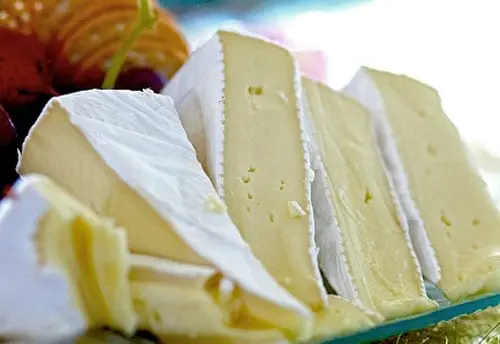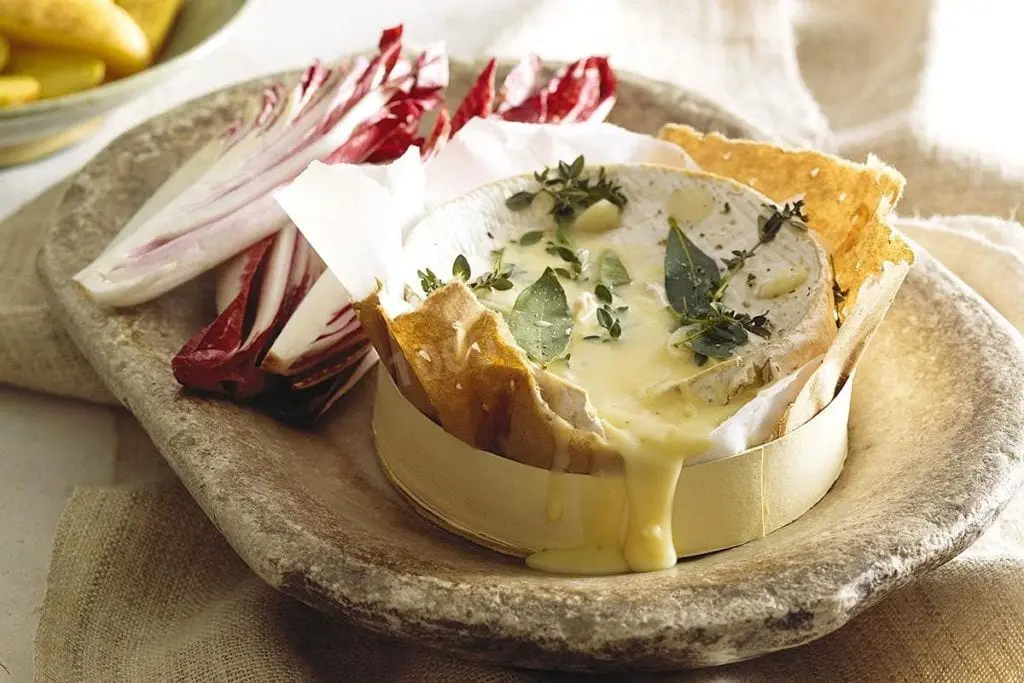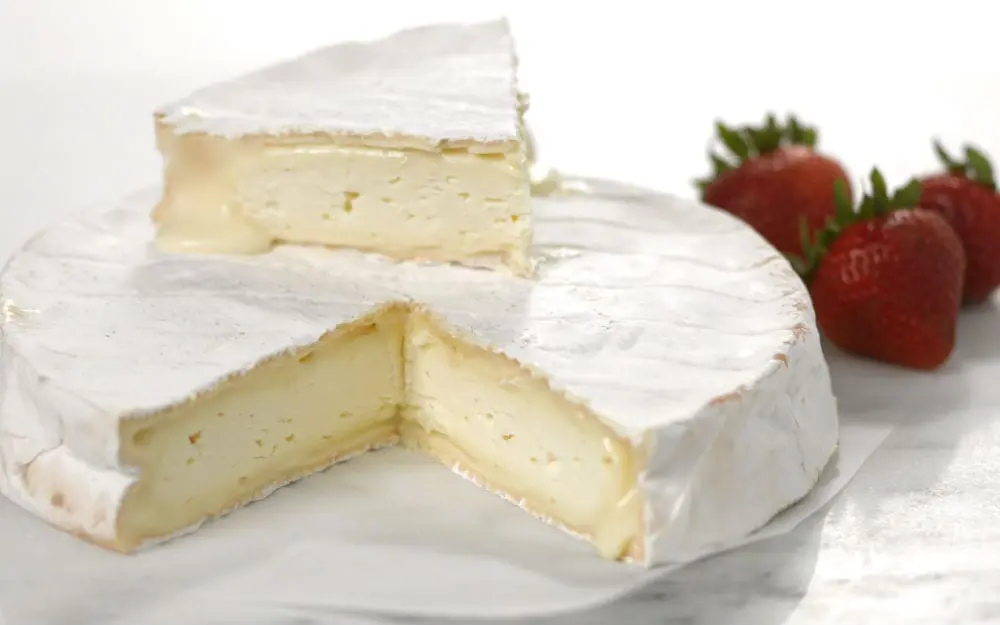Contents
Description
Brie is a soft cheese with a delicate creamy taste and nutty and mushroom notes. Brie is a type of cheese that shares the same name as the old French province. Its light or grayish flesh is covered with a white crust that can also be eaten. The better the brie ripens, the less soft its crust becomes, and the specific aroma and piquant taste intensify. This delicious cheese can be eaten alone or used as an ingredient.
Main characteristics of brie
Origin
Province of Ile-de-France (France).
Cooking method
In whole or skimmed cow’s milk, rennet is added and heated to 37 ° C. The curd is spread into marble molds using a special brie scoop (pelle à brie). Leave for 18 hours, after which it is removed from the molds, salted and introduced into it the mold Penicillium candidum. Thanks to him, the cheese has a light crust, and the structure becomes soft. The cheese is placed in cellars for maturation, where it “ripens” for 1-2 months.
Colour
Pale with a grayish tinge, mold of the same color.

Ripening period
30 days.
Taste and consistency
Taste – delicate creamy with nut and mushroom notes; consistency – moist, elastic, melting.
Properties
- Energy value (100 g): 291 kcal.
- Nutritional value (100 g): protein – 21 g, fat – 23 g, calcium, phosphorus, potassium.
- Vitamins and minerals: vitamins A, PP and group B.
- Fat content: from 40 to 50%.
- Storage: at a temperature of +2 – 5 ° C in an individually sealed package for no more than 3 days.
The history of brie cheese
Firstly, the history of Brie cheese began in medieval France, in the village of Meaux, near Paris, but cheeses of this type were made throughout France even before the Roman conquest of Gaul, as evidenced by the wide variety of types of cheese with a white mold covered in this country.
One of the first documented mentions of Brie cheese is the chronicle of the Frankish emperor Charlemagne: in 774 he stayed in Brie and tasted the already famous local cheese and left him the most flattering review: “I just tasted one of the most delicious dishes.”
The fact that Moe has always been home to one of the largest cheese markets in the province probably helped to make Brie well known. Brie has always been marked by royal love and even according to legend, was the cause of the death of one of the kings of France.

Interesting historic facts
Louis XVI, who, like many kings, was a great gourmet and connoisseur of cheeses, tried to save his life by flight in 1789, at the beginning of the Great French Revolution. Driving past the village where the most delicious Brie in France was made, Louis could not resist and asked to stop the carriage to try his favorite cheese for the last time.
This delay cost the king his life: he was caught, taken back to Paris and executed. In conclusion, this legend is far from the generally accepted historical version of events.
Louis was recognized and arrested in Varennes, in Lorraine, which is 210 km from Meaux, at that time the distance was considerable. But people persistently retell this parable about the gourmet king who lost his crown and head over a slice of Brie cheese.
Among the crowned and noble admirers of this wonderful cheese are King Philip Augustus, Countess Blanche of Navarre, King Charles of Orleans, Queen Margot, Henry IV the Great of Navarre. The Great French Revolution made Brie accessible to the common people, making it a kind of symbol of equality between the rich and the poor French.
How to eat brie cheese

At a banquet or party, this type of cheese is usually served in slices, along with a crust. If you don’t like to eat it, or don’t even want to try it (and in vain!), Just use a knife to separate it from the piece of cheese. This gourmet dish can be eaten on its own, but it’s even better to complement its exquisite taste of next products:
- white crackers
- French bread
- pears, apples or other fruits,
- candied walnuts or almonds,
- honey, cherry or fig jam.
Food instance brie also goes well with many drinks that emphasize its juiciness and softness favorably. The list oof drinks:
- Stout and some dark beers.
- Vignone, Marsanne, Riesling and other dry wines.
- Light red wines like Pinot Noir.
- Fresh juices, apple cider.
How to determine the freshness of cheese

The crust should be firm and the inside elastic. Unripe cheese is too hard, while overripe cheese is thin and soft. Until the cheese wheel is cut, the cheese continues to ripen. As soon as even a small piece is cut off from it, ripening stops.
Cut brie has a shelf life of two days in the refrigerator. Then it can be thrown away. If stored improperly, cheese will develop brown spots, bruises and an unhealthy ammonia smell.
How to serve correctly
For the cheese to fully develop, it must warm to room temperature. This can be done naturally, as well as in the oven or microwave (just a few seconds!).
A wedge of cheese is placed on a platter, surrounded by white crackers and French bread, grapes (sliced apples, pears and other fruits) and nuts. Be sure to put a knife for each guest, and if necessary, demonstrate how to use it to cut small pieces of brie or cut off the crust.
Dishes with Brie

- Baked Brie.
- There are a lot of recipes. One of the best is the incredibly delicious brie dessert baked with cranberries.
- Brie with a crust. A small circle of cheese is wrapped in puff pastry, covered with an egg on top and baked in the oven. There are thousands of possibilities to diversify this simple dish: add nuts, raspberry jam, etc.
- Stuffed Salmon with Brie. This cheese is equally good not only in sweet but also in spicy dishes. Bake the salmon, stuffed with brie mixed with crispy pine nuts, onions and peppers.
- Cheese sauce or pesto. A great addition to many dishes.
- Brie Cheese Sandwiches. Cooking them is fun, and great results are guaranteed – after all, brie can be combined with almost any product. Mushrooms, cranberries, basil, marinara sauce, mustard, ham, avocado, bacon, or whatever.
- A recipe invented by you personally. This fantastic product opens up unlimited space for imagination.

6 Interesting facts about brie
- The French do not heat this type of cheese before they eat it. He is good in any form.
- The taste is revealed better with bread than without it.
- It is better to cut from the edge to the center so as not to squeeze out the soft inner part.
- The texture of young cheese is softer, while mature cheese becomes slightly brittle, but acquires a stronger taste and aroma.
- Brie can be preheated in the oven (in foil) before serving, so it can be spread over toast and crackers.
- Eat soft cheese with a crust. Despite the slight bitterness, the crust tastes delicious.
Beneficial features of brie

The benefits of Brie cheese lie in its chemical composition. Firstly, it contains vitamin A, which is important not only for vision, but also for the production of collagen, which maintains the beauty of the skin. Thanks to B vitamins, the functioning of the nervous system improves, which in turn helps with insomnia and fatigue. Among the minerals, calcium stands out, which strengthens bone tissue.
It contains magnesium, phosphorus and other minerals. The composition of such cheese practically does not include lactose, which means that people who are allergic to it can use it.
Moreover, brie cheese contains essential amino acids for the body, as well as bacteria that have a positive effect on the activity of the digestive system. This product has been proven to reduce the risk of tooth decay. The mold in this cheese has the ability to protect the skin from sunburn.
Contraindications for brie cheese

Can brie be harmful? In some cases, this is possible, but only on condition of excessive consumption. This can negatively affect the intestinal microflora or cause allergies.
The product is completely contraindicated for people suffering from dysbiosis. The intake of antibiotic substances contained in the mold will only aggravate the ailment, inhibiting the vital activity of beneficial microorganisms.
Cheese should be included with caution in their menu for those who have heart and vascular diseases (it is recommended to first consult with your doctor). This is due to the content of cholesterol, which has a detrimental effect on the state of the blood supply system.









